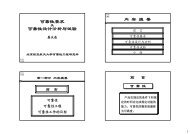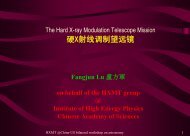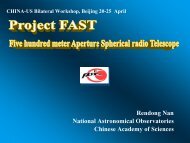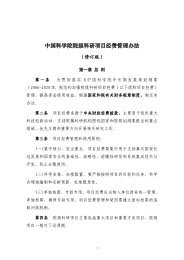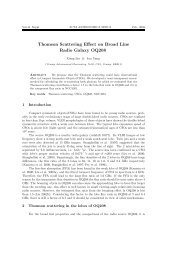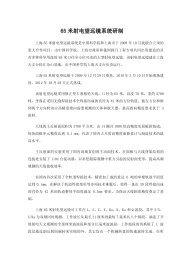Compact Integrated Receivers Using MMIC Technology
Compact Integrated Receivers Using MMIC Technology
Compact Integrated Receivers Using MMIC Technology
Create successful ePaper yourself
Turn your PDF publications into a flip-book with our unique Google optimized e-Paper software.
<strong>Compact</strong> <strong>Integrated</strong> <strong>Receivers</strong><br />
<strong>Using</strong> <strong>MMIC</strong> <strong>Technology</strong><br />
Sino-NRAO Bilateral Workshop<br />
4/24/2008<br />
Matt Morgan<br />
National Radio Astronomy Observatory
Outline<br />
1. Why use <strong>MMIC</strong> <strong>Technology</strong>?<br />
2. Past <strong>MMIC</strong> Developments at NRAO<br />
3. Roadmap to Smaller, Lighter, and Cheaper <strong>Receivers</strong><br />
4. Future Developments
Outline<br />
1. Why use <strong>MMIC</strong> <strong>Technology</strong>?<br />
2. Past <strong>MMIC</strong> Developments at NRAO<br />
3. Roadmap to Smaller, Lighter, and Cheaper <strong>Receivers</strong><br />
4. Future Developments
<strong>Compact</strong> <strong>Integrated</strong> <strong>Receivers</strong><br />
1. critical for focal plane arrays<br />
• beam spacing<br />
• field of view<br />
2. lower mass<br />
• more efficient cryogenics<br />
• tighter temperature control<br />
• reduced mechanical load<br />
3. fewer connectors and cables<br />
• greater reliability<br />
• reduced VSWR effects<br />
• reduced gain slopes<br />
• fewer entry points for RFI
<strong>MMIC</strong> Modules are More <strong>Compact</strong>, Lightweight<br />
and Manufacturable than Conventional Assemblies<br />
Assembly of Individually<br />
Packaged Components<br />
Multi-Chip Module
<strong>MMIC</strong> Modules are <strong>Compact</strong> Enough for Focal Plane Arrays<br />
The size of a well-designed <strong>MMIC</strong> module is typically<br />
dominated by connectors and waveguide flanges.
Many <strong>MMIC</strong>s Available Commercially<br />
Most things below 50 GHz are available off-the-shelf for less than $50<br />
Exceptions include:<br />
• balanced/differential port configurations<br />
• non-standard impedance<br />
• some block-conversion mixers<br />
Some things in the 50-100 GHz range can be found in commercial product<br />
listings, but<br />
• sparse frequency coverage<br />
• usually narrow-band, targeted for specific applications<br />
(communication and radar bands, etc.)<br />
• some exotic functions not supported (compound switches, etc.)<br />
Finally, there is a large pool of proven custom designs to draw from,<br />
designed by research labs around the world (but obtaining these would<br />
generally require purchasing a new wafer run).
Outline<br />
1. Why use <strong>MMIC</strong> <strong>Technology</strong>?<br />
2. Past <strong>MMIC</strong> Developments at NRAO<br />
3. Roadmap to Smaller, Lighter, and Cheaper <strong>Receivers</strong><br />
4. Future Developments
Outline<br />
1. Why use <strong>MMIC</strong> <strong>Technology</strong>?<br />
2. Past <strong>MMIC</strong> Developments at NRAO<br />
• <strong>Compact</strong> Water Vapor Radiometer<br />
• ALMA Local Oscillator Assemblies<br />
3. Roadmap to Smaller, Lighter, and Cheaper <strong>Receivers</strong><br />
4. Future Developments
<strong>Compact</strong> Water Vapor Radiometer<br />
R. Hayward<br />
The <strong>Compact</strong> Water Vaopr Radiometer Module was designed as an add-on<br />
to the K-Band receivers on the EVLA.
<strong>Compact</strong> Water Vapor Radiometer<br />
WVR Bands
<strong>Compact</strong> Water Vapor Radiometer<br />
• input pol switch<br />
• leveling step attenuators<br />
• RF gain<br />
• dark-current switch<br />
• 5-channel multiplexer<br />
• detectors<br />
• chopper-stabilized op-amps<br />
All Commercially available <strong>MMIC</strong>s!
<strong>Compact</strong> Water Vapor Radiometer<br />
Module Dimensions:<br />
9 x 9 x 1.5 cm
Performance of <strong>Compact</strong> Water Vapor Radiometer<br />
Stability:
Outline<br />
1. Why use <strong>MMIC</strong> <strong>Technology</strong>?<br />
2. Past <strong>MMIC</strong> Developments at NRAO<br />
• <strong>Compact</strong> Water Vapor Radiometer<br />
• ALMA Local Oscillator Assemblies<br />
3. Roadmap to Smaller, Lighter, and Cheaper <strong>Receivers</strong><br />
4. Future Developments
ALMA Receiver Cartridge<br />
YIG-tuned<br />
Oscillator<br />
Warm Cartridge<br />
Assembly<br />
Cold Cartridge<br />
Assembly<br />
Cold Mixer-Preamps<br />
Cold LO<br />
Multipliers<br />
Active Multiplier Chain,<br />
PLL Box,<br />
LO Monitor & Control<br />
Warm IF Amps<br />
LO Power<br />
Amplifiers
ALMA Local Oscillator Assemblies<br />
Band # RF Frequency Final Multiplier IF Range mm-wave LO Frequency<br />
Band 1 31.3 – 45 GHz<br />
Band 2 67 – 90 GHz<br />
Band 3 84 – 116 GHz x1 8 GHz 92 – 108 GHz<br />
Band 4 125 – 163 GHz x2 8 GHz 66.5 – 77.5 GHz<br />
Band 5 163 – 211 GHz<br />
Band 6 211 – 275 GHz x3 12 GHz 74.3 – 87.7 GHz<br />
Band 7 275 – 373 GHz x3 8 GHz 94.3 – 121.7 GHz<br />
Band 8 385 – 500 GHz x6 8 GHz 65.5 – 82 GHz<br />
Band 9 602 – 720 GHz x9 8 GHz 67.8 – 79.1 GHz<br />
Band 10 787 – 950 GHz<br />
ALMA LO Assemblies:<br />
• wideband CW source<br />
• no mechanical tuning<br />
• no added noise (
Custom <strong>MMIC</strong> Components for ALMA LO Chains<br />
A large number of custom W-Band<br />
<strong>MMIC</strong>s had to be developed for the<br />
ALMA LO subsystem. These included<br />
• GaAs Schottky Diode Triplers<br />
• GaAs Schottky Diode Balanced<br />
Mixers<br />
• GaAs and InP 0.1 μm pHEMT<br />
Broadband Medium Power Amplifiers<br />
M. Morgan, E. Bryerton, P. Cesarano, T. Boyd, D. Thacker, K. Saini, and S. Weinreb, "A Millimeter-Wave Diode-<strong>MMIC</strong> Chipset<br />
for Local Oscillator Generation in the ALMA Telescope," IEEE Int. Microwave Symposium, Long Beach, CA, June 2005.<br />
L. Samoska, E. Bryerton, M. Morgan, D. Thacker, K. Saini, T. Boyd, D. Pukala, A. Peralta, M. Hu, and A. Schmitz, "Medium<br />
Power Amplifiers Covering 90-130 GHz for the ALMA Telescope Local Oscillators," IEEE Intl. Microwave Symposium, Long<br />
Beach, CA, June 2005.
ALMA Active Multiplier Chain
ALMA LO Power Amplifier Modules<br />
Dual-channel, power-combined <strong>MMIC</strong><br />
PA module.<br />
Detail of the <strong>MMIC</strong> PA with waveguide probes.<br />
Preceding the final submm-wave multipliers in each band is a dual-channel<br />
power amplifier module.
Performance ALMA Active Multiplier Chain<br />
PA – Ch. 1<br />
PA – Ch. 2<br />
AMC<br />
Band 6<br />
The output power required from the mm-wave LO system varies<br />
from about 10-100 mW depending on the multiplier it must drive<br />
to reach the submm-wave band.
Outline<br />
1. Why use <strong>MMIC</strong> <strong>Technology</strong>?<br />
2. Past <strong>MMIC</strong> Developments at NRAO<br />
3. Roadmap to Smaller, Lighter, and Cheaper <strong>Receivers</strong><br />
4. Future Developments
Working Toward an All-<strong>MMIC</strong> Receiver<br />
1. Once a design is set, <strong>MMIC</strong> components and assemblies can be massproduced<br />
with exceptional repeatability<br />
• especially in the cm-wave range, where most <strong>MMIC</strong>s are<br />
commercially available – chips are screened by the manufacturer<br />
and their specs guaranteed.<br />
• module assembly is insensitive to small variations – bondwires are<br />
used for 50 Ω interconnects, not for tuning!<br />
2. Failures are relatively easy to diagnose and repair<br />
• because of the inherent uniformity in performance, device failure is<br />
usually apparent from the DC bias alone.<br />
• when it isn't, one can usually open up the module and probe-test the<br />
chips in-place to find the culprit<br />
• the chips are cheap enough (
Progression from Conventional to <strong>Integrated</strong> <strong>Receivers</strong><br />
PAST<br />
PRESENT<br />
FUTURE<br />
15K<br />
<strong>MMIC</strong><br />
Module<br />
15K<br />
Conventional<br />
Subassembly<br />
300K<br />
<strong>MMIC</strong><br />
Module<br />
15K<br />
Conventional<br />
Subassembly<br />
to Back End<br />
300K<br />
Conventional<br />
Subassembly<br />
300K<br />
<strong>MMIC</strong><br />
Module<br />
to Back End<br />
to Back End
Could We Put the Whole Receiver in One<br />
<strong>MMIC</strong>-Module and Cool Everything?<br />
Not if it is a heterodyne receiver, because<br />
• LO generation dissipates too much power for cryogenics<br />
• IF components are usually Silicon, which will not function cold<br />
However, special-purpose direct detection receivers could occupy<br />
a single cold module<br />
• even more compact<br />
• better sensitivity<br />
• better temperature stability<br />
• better component lifetime
Outline<br />
1. Why use <strong>MMIC</strong> <strong>Technology</strong>?<br />
2. Past <strong>MMIC</strong> Developments at NRAO<br />
3. Roadmap to Smaller, Lighter, and Cheaper <strong>Receivers</strong><br />
4. Future Developments
<strong>MMIC</strong> Wish List:<br />
Wide-IF Block-Conversion Mixers<br />
<strong>MMIC</strong><br />
RF<br />
IF<br />
LO<br />
LO<br />
IF<br />
RF<br />
image<br />
Overlapping RF and IF Bands – requires triple-balanced topology?
Wideband Differential LNAs<br />
<strong>MMIC</strong><br />
transfer<br />
switch<br />
Z 0<br />
Should be impedance-matched to self-complementary<br />
log-periodic antennas (Z 0<br />
= η 0<br />
/2 = 189 Ω)
Another Problem: Why are those bias boards so big?<br />
Because we put a lot on them!<br />
• linear regulators<br />
• potentiometers for tuning and gain<br />
control<br />
• digital logic for configuration switching<br />
and channel selection<br />
• Op-Amps for gate servo loops and<br />
monitor points<br />
• IF circuitry<br />
It makes for a user-friendly module, but<br />
if we're serious about compactness,<br />
particularly for focal plane arrays, then we<br />
must find a way to trim this part down.
One Solution: Develop Common Bias Blocks in Die Form<br />
or <strong>Integrated</strong> SMT Packages<br />
Two external resistors<br />
set the desired drain<br />
voltage and current.<br />
Probably very expensive!<br />
(unless we buy millions of them)<br />
Not suitable for cooling if done<br />
in Silicon.
Shall we take integration a step further:<br />
Receiver-on-a-Chip?<br />
Personally, I would say no...<br />
• LNAs, mixers, and multipliers have all been demonstrated on common<br />
semiconductor technologies, but with compromised performance – better<br />
to pick the right <strong>MMIC</strong> process for the right chip<br />
• even if it works, the yield is too low on III-V semiconductors for large-scale<br />
integration<br />
• a lot of expensive wafer real estate is wasted on passives<br />
• can no longer take advantage of commercial components – have to design<br />
it all from scratch<br />
• little or no opportunity for chip reuse<br />
• Microwave substrates are thin! A large, floppy chip would be too hard to<br />
handle and mount without damaging it.
References<br />
[1] E. Bryerton, M. Morgan, D. Thacker, and K. Saini, "Maximizing<br />
Signal-to-Noise Ratio in Local Oscillator Chains for Sideband-<br />
Separating Single-Ended Mixers," 18th Intl. Symp. on Space<br />
Terahertz <strong>Technology</strong>, Pasadena, CA, March 2007.<br />
[2] Y. Tang, N. Wadefalk, M. Morgan, and S. Weinreb, "Full Ka-Band<br />
High Performance InP <strong>MMIC</strong> LNA Module," IEEE MTT-S Intl.<br />
Microwave Symposium, San Francisco, CA, June 2006.<br />
[3] M. Morgan, "Custom GaAs and InP Components for Radio<br />
Astronomy," IEEE Compound Semiconductor IC Symp., Palm<br />
Springs, CA, November 2005.<br />
[4] E. Bryerton, K. Saini, M. Morgan, M. Stogoski, T. Boyd, and D.<br />
Thacker, "Development of Electronically Tuned Local Oscillators for<br />
ALMA," The Joint 30th Intl. Conf. on Infrared and Millimeter Waves<br />
and 13th Intl. Conf. on Terahertz Electronics, Williamsburg, VA,<br />
September 2005.<br />
[5] M. Morgan, E. Bryerton, P. Cesarano, T. Boyd, D. Thacker, K. Saini,<br />
and S. Weinreb, "A Millimeter-Wave Diode-<strong>MMIC</strong> Chipset for Local<br />
Oscillator Generation in the ALMA Telescope," IEEE MTT-S Intl.<br />
Microwave Symposium, Long Beach, CA, June 2005.<br />
[6] L. Samoska, E. Bryerton, M. Morgan, D. Thacker, K. Saini, T. Boyd,<br />
D. Pukala, A. Peralta, M. Hu, and A. Schmitz, "Medium Power<br />
Amplifiers Covering 90-130 GHz for the ALMA Telescope Local<br />
Oscillators," IEEE MTT-S Intl. Microwave Symposium, Long Beach,<br />
CA, June 2005.<br />
[7] M. Morgan and S. Weinreb, "Techniques for the Integration of High-<br />
Q Millimeter-Wave Filters in Multi-Function <strong>MMIC</strong> Modules,"<br />
Microwave Journal, vol. 48, no. 5, pp. 182-196, May 2005.<br />
[8] M. Morgan, N. Wadefalk, and S. Weinreb, "A Wideband <strong>MMIC</strong> LNA<br />
for the 11 to 34 GHz Band," URSI National Radio Science Meeting,<br />
Boulder, CO, January 2005.<br />
[9] C. Chandler, W. Brisken, B. Butler, R. Hayward, M. Morgan, and B.<br />
Willoughby, "A proposal to design and implement a compact water<br />
vapour radiometer for the EVLA," EVLA Memo #74, July 2004.<br />
[10] M. Morgan and S. Weinreb, "A W-Band monolithic medium power<br />
amplifier," IEEE MTT-S Intl. Microwave Symp. Digest, pp. 133-136,<br />
Philadelphia, PA, 2003.<br />
[11] M. Morgan and S. Weinreb, "A millimeter-wave perpendicular coaxto-microstrip<br />
transition," IEEE MTT-S Intl. Microwave Symp. Digest,<br />
pp. 817-820, Seattle, WA, 2002.<br />
[12] M. Morgan, S. Weinreb, N. Wadefalk, and L. Samoska, "A <strong>MMIC</strong>based<br />
75-110 GHz signal source," IEEE MTT-S Intl. Microwave<br />
Symp. Digest, pp. 1859-1862, Seattle, WA, 2002.<br />
[13] K. Lin, H. Wang, M. Morgan, T. Gaier, and S. Weinreb, "A W-Band<br />
GCPW <strong>MMIC</strong> diode tripler," 32nd European Microwave Conference,<br />
Milan, 2002.<br />
[14] V. Radisic, M. Micovic, M. Hu, P. Janke, C. Ngo, L. Nguyen, L.<br />
Samoska, and M. Morgan, "164-GHz <strong>MMIC</strong> HEMT doubler," IEEE<br />
Microwave and Wireless Components Letters, vol. 11, pp. 241-243,<br />
June 2001.<br />
[15] M. Morgan and S. Weinreb, "A full waveguide band <strong>MMIC</strong> tripler for<br />
75-110 GHz," IEEE MTT-S Intl. Microwave Symp. Digest, pp. 103-<br />
106, Phoenix, AZ, 2001.<br />
[16] M. Morgan and S. Weinreb, "A monolithic HEMT diode balanced<br />
mixer for 100-140 GHz," IEEE MTT-S Intl. Microwave Symp. Digest,<br />
pp. 99-102, Phoenix, AZ, 2001.



